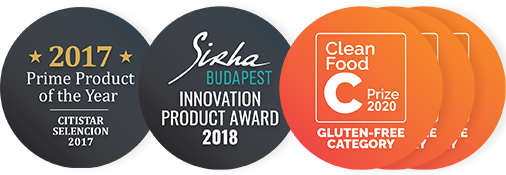Our lifestyle and nutrition play an important role in staying healthy and preventing diseases. More and more people are aware of this and carefully choose food ingredients and commercially available foods.
Those who follow a healthy diet place great emphasis on fresh, natural foods and often avoid not only preservatives, synthetic dyes and aromas, but “everything-free” nutrition is becoming more and more fashionable.
Another large group of conscious buyers of “free” products are, on the one hand, those suffering from food intolerance, the cornerstone of their treatment is a diet aimed at avoiding the agent that causes sensitivity, which results in lasting improvement and freedom from complaints. On the other hand, diagnosed food allergy sufferers for whom it is vital to avoid certain allergens.
Food labels provide useful information for both groups. For patients, however, it is essential that the (allergen) markings on food labels are accurate, clear and understandable.
On October 25, 2011, the European Parliament and the Council adopted Regulation 1169/2011/EU on consumer information on food, which provides consumers with a basis for informed choice and safe use of food. According to the regulations applicable after December 13, 2014, the ingredients causing allergies must also be visually highlighted (usually in bold) in the list of ingredients on food packaging (the list of these is contained in Annex No. 2 of the regulation). Labeling of allergens is also mandatory for non-prepackaged foods, i.e. in this regard, the law applies, e.g. also for meals and foodstuffs sold in bakeries, catering and public catering.
The total of 14 types of mandatory ingredients are:
- Cereals containing gluten, namely: wheat, rye, barley, oats, spelt, kamut or their hybridised strains, and products thereof, except:
- wheat based glucose syrups including dextrose
- wheat based maltodextrins
- glucose syrups based on barley
- cereals used for making alcoholic distillates including ethyl alcohol of agricultural origin
- Crustaceans and products thereof
- Eggs and products thereof
- Fish and products thereof, except:
- fish gelatine used as carrier for vitamin or carotenoid preparations
- fish gelatine or Isinglass used as fining agent in beer and wine
- Peanuts and products thereof
- Soybeans and products thereof, except:
- fully refined soybean oil and fat
- (b) natural mixed tocopherols (E306), natural D-alpha tocopherol, natural D-alpha tocopherol acetate, and natural D-alpha tocopherol succinate from soybean sources
- vegetable oils derived phytosterols and phytosterol esters from soybean sources
- plant stanol ester produced from vegetable oil sterols from soybean sources
- Milk and products thereof (including lactose), except:
- whey used for making alcoholic distillates including ethyl alcohol of agricultural origin
- lacitol
- Nuts, namely: almonds (Amygdalus communis L.), hazelnuts (Corylus avellana), walnuts (Juglans regia), cashews (Anacardium occidentale), pecan nuts (Carya illinoinensis (Wangenh.) K. Koch), Brazil nuts (Bertholletia excelsa), pistachio nuts (Pistacia vera), macadamia or Queensland nuts (Macadamia ternifolia), and products thereof, except for nuts used for making alcoholic distillates including ethyl alcohol of agricultural origin;
- Celery and products thereof
- Mustard and products thereof
- Sesame seeds and products thereof
- Sulphur dioxide and sulphites at concentrations of more than 10 mg/kg or 10 mg/litre in terms of the total SO2 which are to be calculated for products as proposed ready for consumption or as reconstituted according to the instructions of the manufacturers
- Lupin and products thereof
- Molluscs and products thereofs.



